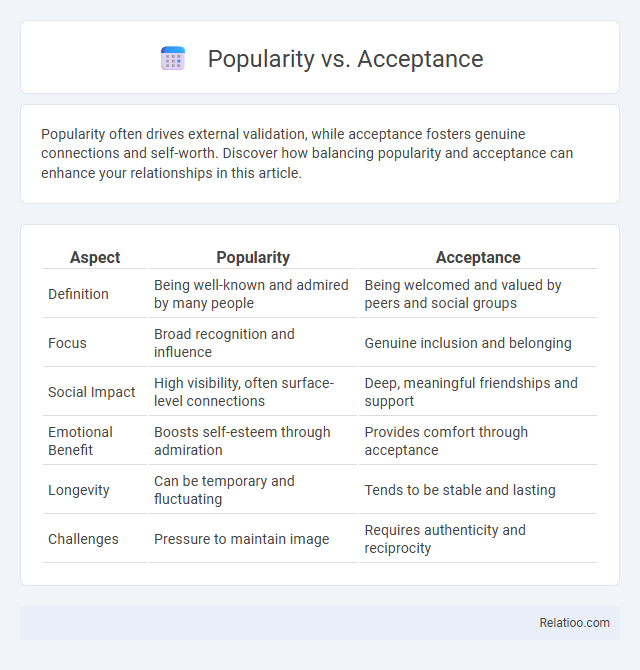Popularity often drives external validation, while acceptance fosters genuine connections and self-worth. Discover how balancing popularity and acceptance can enhance your relationships in this article.
Table of Comparison
| Aspect | Popularity | Acceptance |
|---|---|---|
| Definition | Being well-known and admired by many people | Being welcomed and valued by peers and social groups |
| Focus | Broad recognition and influence | Genuine inclusion and belonging |
| Social Impact | High visibility, often surface-level connections | Deep, meaningful friendships and support |
| Emotional Benefit | Boosts self-esteem through admiration | Provides comfort through acceptance |
| Longevity | Can be temporary and fluctuating | Tends to be stable and lasting |
| Challenges | Pressure to maintain image | Requires authenticity and reciprocity |
Defining Popularity and Acceptance
Popularity reflects the level of widespread recognition and admiration an individual, product, or idea receives from a large audience, often driven by trends and social influence. Acceptance denotes a deeper level of approval characterized by genuine embrace, respect, or endorsement within a community or group, signaling meaningful integration beyond mere recognition. Defining popularity involves assessing quantitative metrics like followers, views, or market penetration, while acceptance emphasizes qualitative aspects such as trust, cultural resonance, and sustained support.
Key Differences Between Popularity and Acceptance
Popularity often depends on widespread recognition or social status, while acceptance is rooted in genuine approval and belonging within a group. Popularity may be fleeting and based on external factors, whereas acceptance signifies deeper emotional connection and trust. Understanding these distinctions helps clarify why someone can be popular without being truly accepted.
Psychological Roots of Popularity
Popularity stems from social validation and the human need for belonging, while acceptance reflects deeper emotional connection and genuine inclusion. Understanding the psychological roots of popularity reveals that You often seek external approval to boost self-esteem and social status. True acceptance, however, satisfies intrinsic desires for authenticity and meaningful relationships.
The Social Dynamics of Acceptance
Social dynamics of acceptance revolve around genuine inclusion rather than superficial popularity; acceptance reflects authentic connections where your values and identity are respected. Popularity often depends on visibility and social status but does not guarantee belonging or emotional support within groups. Understanding the difference between popularity and acceptance helps you build meaningful relationships rooted in trust and mutual respect.
Cultural Influences on Popularity and Acceptance
Cultural influences shape how popularity and acceptance are perceived and valued within different social groups, affecting your ability to connect and be recognized. Popularity often reflects widespread admiration influenced by cultural trends, while acceptance signifies deeper social inclusion based on shared values and norms. Understanding these cultural dynamics helps navigate social environments more effectively, balancing visibility with genuine belonging.
Impact on Personal Identity
Popularity often shapes outward perceptions and social influence, while acceptance fosters genuine belonging and self-worth, deeply impacting personal identity development. The pursuit of popularity can lead to compromising authentic values, whereas acceptance reinforces a stable and positive self-concept. Balancing the desire for popularity with acceptance helps individuals maintain integrity and cultivate meaningful relationships that support identity growth.
Popularity vs Acceptance in Schools and Workplaces
Popularity in schools and workplaces often reflects social visibility and peer recognition, while acceptance indicates genuine inclusion and respect within the community. Students or employees may be popular due to charisma or achievements, but without acceptance, they might face social exclusion or limited collaboration. Fostering acceptance over mere popularity enhances group cohesion, mental well-being, and long-term success in educational and professional environments.
Social Media’s Role in Shaping Perception
Social media platforms play a crucial role in shaping public perception by influencing the popularity and acceptance of ideas, products, and personalities. While popularity often reflects widespread visibility and engagement metrics like likes and shares, acceptance indicates deeper endorsement and trust among your audience, impacting long-term reputation and influence. Understanding the distinction between popularity and acceptance helps you leverage social media effectively to build meaningful connections beyond transient trends.
Long-Term Effects on Mental Health
Popularity often leads to short-term social validation but may increase anxiety and stress due to constant social comparison and pressure to maintain status. Acceptance, grounded in genuine relationships and self-worth, fosters long-term emotional resilience and reduces feelings of loneliness and depression. Consistent acceptance promotes sustainable mental health benefits, while fleeting popularity can contribute to emotional instability over time.
Strategies for Balancing Popularity and Acceptance
Strategies for balancing popularity and acceptance involve cultivating genuine relationships and fostering inclusivity within social or professional environments. Emphasizing active listening, empathy, and consistent authentic behavior helps bridge the gap between superficial popularity and deep acceptance. Leveraging social intelligence and emotional awareness promotes trust, encouraging sustainable connections that blend wide appeal with meaningful acceptance.

Infographic: Popularity vs Acceptance
 relatioo.com
relatioo.com